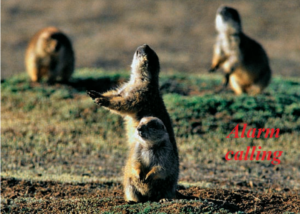Unique behaviours among wild animals.(1)

Unique behaviours among wild animals.
Nest building behavior in lovebirds.
- Lovebirds are small, green, and pink African parrots that nest in tree hollows.
- There are several closely related species of lovebirds in the genus Agapornis that build their nests differently.
- Fischer lovebirds cut large leaves (or in the laboratory, pieces of paper) into long strips with their bills.
- They use their bills to carry the strips to the nest, where they weave them in with others to make a deep cup.
- Peach-faced lovebirds cut somewhat shorter strips and they carry them to the nest in a very unusual manner.
- They pick up the strips in their bills and then insert them into their feathers.
- In this way, they can carry several of these short strips with each trip to the nest, while Fischer lovebirds can carry only one of the longer strips at a time.
- When the two species of birds were mated, the hybrid birds had difficulty carrying nesting materials.
- They cut strips of intermediate length and then attempt to tuck the strips into their rump feathers.
- They do not push the strips far enough into the feathers, however, and when they walk or fly, the strips always come out.
- Hybrid birds will also eventually (about three years in this study) learn to carry the cut strips in their beak, but they still briefly turn their head toward their rump before flying off.
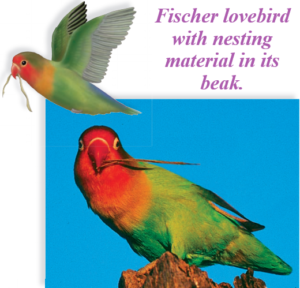
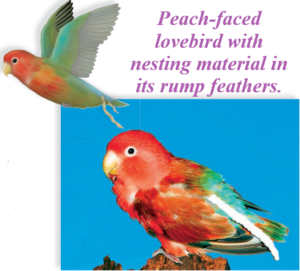
Sexual Selection in Male Bowerbirds
At the start of the breeding season, male bowerbirds use small sticks and twigs to build elaborate display areas called bowers.
They clear the space around the bower and decorate the area with fresh flowers, fruits, pebbles, shells, bits of glass, tinfoil, and any bright baubles they can find.
The Satin Bowerbird of eastern Australia prefers blue objects, a colour that harmonizes with the male’s glossy blue-back plumage.
Males collect blue parrot feathers, flowers, berries, ballpoint pens, clothespins, and even toothbrushes from researchers’ cabins.
After the bower is complete, a male bower bird spends most of his time near this bower, calling to females, renewing his decorations, and guarding his work against possible raids by other males.
After inspecting many bowers and their owners, a female approach one, and the male begins a display.
He faces her, fluffs up his feathers, and flaps his wings to the beat of a call.
The female enters the bower, and if she crouches, the two mate.
Female bowerbirds build their own nests and raise the young without help from their mates, so attractive males can mate with multiple females.
The reproductive advantage gained by attractive male bowerbirds is quite large
The most attractive males may mate with up to 25 females per year, but most males mate rarely or not at all.
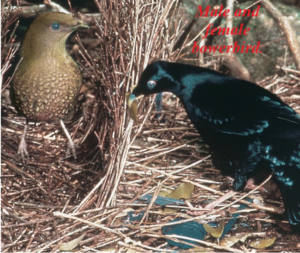
Male fireflies have developed light flashes that are species-specific about the number and duration of flashes.
Females respond with a flash of their own. Such bright flashes are also bound to attract predators.
Some female fireflies use mimicry to their advantage.
Female fireflies of the species Photuris versicolor mimic the flashing responses normally given by females of other species, such as Photinus tanytoxus, to lure the males of those species close enough to eat them.

Some animals are capable of secreting different pheromones, each with a different meaning.
Pheromones are chemical signals in low concentration that are passed between members of the same species.
- Female moths secrete chemicals from special abdominal glands, which are detected downwind by receptors on male antennae.
The antennae are especially sensitive, and this ensures that only male moths of the correct species (not predators) will be able to detect them.
- Ants move in straight trails but have no eyes why?
Ants and termites mark their trails with pheromones.
- A queen bee releases pheromones that suppress the reproductive system of workers, which ensures that she is the only reproductive female in the hive.
- Cheetahs require a large territory in order to hunt for their prey and, therefore, they use means of marking their territory that will last for a while.
Cheetahs and other cats mark their territories by depositing urine, feces, and anal gland secretions at the boundaries.
- Klipspringers (small antelope) use secretions from a gland below the eye to mark twigs and grasses of their territory.
Gibbons live in the tropical rainforest of South and Southeast Asia.
Normally, their home range can be covered in about 3–4 days, and they are also monogamous and territorial.
Territories are maintained by loud singing.
Males sing just before sunrise, and mated pairs sing duets during the morning.
Males, but not females, show evidence of fighting to defend their territory in the form of broken teeth and scars.
Obviously, the defense of territory has a certain cost; it takes energy to sing and fight off others.
Also, you might get hurt.
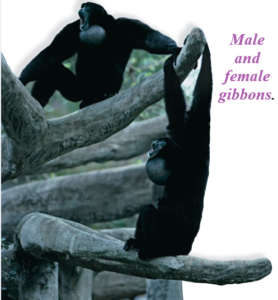
Among Hamadryas baboons, Papio hamadryas, a male, which is silver-white and twice the size of a female, keeps and guards a harem of females with whom he mates exclusively.
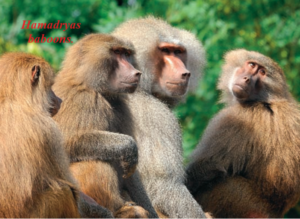
The squirrels feed in groups, with certain individuals acting as sentries and watching for predators.
As a predator approaches, the sentry typically gives an alarm call, and the group members retreat into their burrows.
